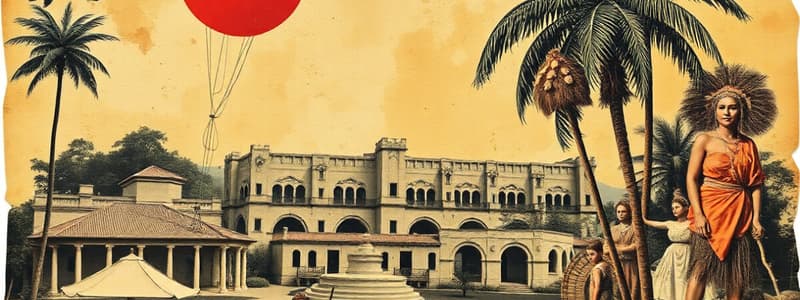Podcast
Questions and Answers
What was a significant contribution of the Diquís civilization around 600 AD?
What was a significant contribution of the Diquís civilization around 600 AD?
- Creating advanced agricultural techniques
- Crafting mysterious stone spheres (correct)
- Establishing trade with North America
- Developing a written language
Which factor primarily contributed to Costa Rica's unique national mindset during Spanish control?
Which factor primarily contributed to Costa Rica's unique national mindset during Spanish control?
- The presence of military governance
- The use of indigenous labor on farms
- The establishment of coffee plantations
- The settlers' independent farming practices (correct)
Which event marked Costa Rica's decision to become an independent country in 1821?
Which event marked Costa Rica's decision to become an independent country in 1821?
- The declaration of war against Spain
- The overthrow of a military dictator
- The signing of the Central American Act
- The Battle of Ochomogo (correct)
What major export products significantly contributed to Costa Rica's income in the late 19th and early 20th centuries?
What major export products significantly contributed to Costa Rica's income in the late 19th and early 20th centuries?
Which significant action did President José Figueres take in 1948?
Which significant action did President José Figueres take in 1948?
Flashcards are hidden until you start studying
Study Notes
Pre-Columbian Costa Rica
- Hunter-gatherers migrated from North to South America, some settling in Costa Rica.
- They began farming, building villages, and creating unique ceramics.
- The "Diquís" civilization was prominent, known for crafting golden pendants and mysterious stone spheres, carved from igneous rock around 600 AD.
Colonial Era
- Christopher Columbus landed in Costa Rica for two and a half weeks in 1502, obtaining gold from the natives. This may have inspired the country's name, "Costa Rica" meaning “Rich Coast.”
- Spain controlled Costa Rica but largely neglected it, focusing on more resource-rich areas.
- Settlers established farms and worked the land independently, without using slaves or natives. This fostered a unique and autonomous national mind-set.
Independence and Early Years
- Costa Rica gained independence in 1821, after Mexico defeated Spain.
- In 1821, Costa Rica decided to become its own country, rather than joining Mexico, after the Battle of Ochomogo.
- Juan Mora Fernández was elected the first president.
- Costa Rica remained largely isolated, focusing on internal affairs.
- They gained significant income from coffee exported to Europe.
Late 19th and Early 20th Centuries
- Coffee and bananas became major exports, alongside coffee.
- The 1871 Constitution guaranteed religious tolerance.
- Costa Rica became known for its order and democracy.
- A military dictator was overthrown by the people in 1948.
- President José Figueres abolished the army, a decision that has remained effective to this day.
Modern Costa Rica
- Known as the "Switzerland of Central America" for its peaceful nature.
- President Óscar Arias received the 1987 Nobel Peace Prize for his efforts toward reducing regional tensions.
- Costa Rica is renowned for its environmentally friendly policies and is among the greenest and happiest nations in the world.
- Costa Rica has a high Human Development Index and the second highest life expectancy in the Americas.
Pre-Columbian Costa Rica
- Hunter-gatherers migrated from North to South America, settling in Costa Rica.
- Early inhabitants engaged in agriculture, village building, and ceramic production.
- The Diquís civilization flourished, renowned for golden pendants and enigmatic stone spheres carved from igneous rock around 600 AD.
Colonial Era
- Christopher Columbus landed in Costa Rica for two and a half weeks in 1502, acquiring gold from the natives. This may have inspired the country's name, "Costa Rica," meaning "Rich Coast."
- Spain asserted control but largely overlooked Costa Rica, focusing on more resource-rich territories.
- Settlers established farms and worked the land independently without relying on slaves or native labor, fostering a unique and autonomous national identity.
Independence and Early Years
- Costa Rica achieved independence in 1821, following Mexico's victory over Spain.
- In 1821, after the Battle of Ochomogo, Costa Rica opted for independence rather than joining Mexico.
- Juan Mora Fernández was elected the first president.
- Costa Rica remained largely isolated, prioritizing internal affairs.
- Coffee exports to Europe brought substantial income.
Late 19th and Early 20th Centuries
- Coffee and bananas became major exports alongside coffee.
- The 1871 Constitution guaranteed religious tolerance.
- Costa Rica gained recognition for its order and democracy.
- A military dictator was overthrown by the people in 1948.
- President José Figueres abolished the army, a decision that remains in effect.
Modern Costa Rica
- Known as the "Switzerland of Central America" for its peaceful nature.
- President Óscar Arias received the 1987 Nobel Peace Prize for his efforts in reducing regional tensions.
- Costa Rica is celebrated for its environmentally friendly policies, ranking among the greenest and happiest nations globally.
- Costa Rica boasts a high Human Development Index and the second highest life expectancy in the Americas.
Studying That Suits You
Use AI to generate personalized quizzes and flashcards to suit your learning preferences.




